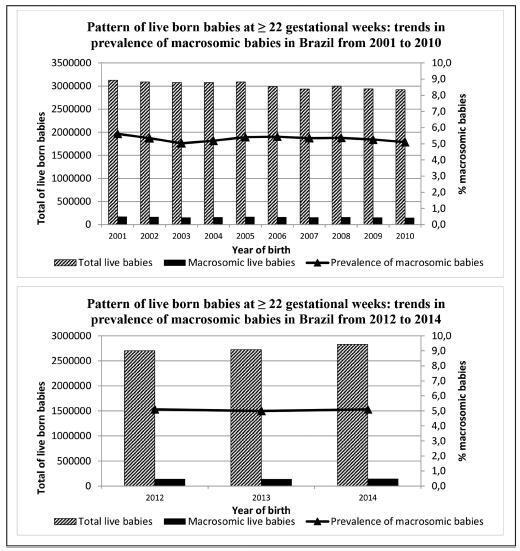Summary
Revista Brasileira de Ginecologia e Obstetrícia. 2019;41(11):647-653
12-20-2019
The present study aims to compare the maternal and fetal outcomes of parturients with and without a gestational diabetes diagnosis.
A case-control study including parturients with (cases) and without (control) a gestational diabetes diagnosis, who delivered at a teaching hospital in Southern Brazil, between May and August 2018. Primary and secondary data were used. Bivariate analysis and a backward conditionalmultivariate logistic regression were used to make comparisons between cases and controls, which were expressed by odds ratio (OR), with a 95% confidence interval (95%CI) and a statistical significance level of 5%.
The cases (n=47) weremore likely to be 35 years old or older compared with the controls (n=93) (p<0.001). The cases had 2.56 times greater chance of being overweight (p=0.014), and a 2.57 times greater chance of having a positive family history of diabetes mellitus (p=0.01). There was no significant difference regarding weight gain, presence of a previous history of gestational diabetes, height, or delivery route. The mean weight at birth was significantly higher in the infants of mothers diagnosed with diabetes (p=0.01). There was a 4.7 times greater chance of macrosomia (p<0.001) and a 5.4 times greater chance of neonatal hypoglycemia (p=0.01) in the infants of mothers with gestational diabetes.
Therefore, maternal age, family history of type 2 diabetes, obesity and pregestational overweightness are important associated factors for a higher chance of developing gestational diabetes.
Summary
Revista Brasileira de Ginecologia e Obstetrícia. 2017;39(8):376-383
08-01-2017
To describe the trends in the prevalence of macrosomia (birth weight ± 4,000 g) according to gestational age in Brazil in the periods of 2001-2010 and 2012-2014.
Ecological study with data from the Brazilian Live Birth Information System (SINASC, in the Portuguese acronym) regarding singleton live newborns born from 22 gestational weeks. The trends in Brazil as a whole and in each of its five regions were analyzed according to preterm (22-36 gestational weeks) and term (37-42 gestational weeks) strata. Annual Percent Changes (APCs) based on the Prais-Winsten method and their respective 95% confidence intervals (CIs) were used to verify statistically significant changes in 2001-2010.
In Brazil, the prevalence of macrosomic births was of 5.3% (2001-2010) and 5.1% (2012-2014). The rates were systematically higher in the North and Northeast Regions both in the preterm and in term strata. In the preterm stratum, the North Region presented the highest variation in the prevalence of macrosomia (+137.5%) when comparing 2001 (0.8%) to 2010 (1.9%). In the term stratum, downward trends were observed in Brazil as a whole and in every region. The trends for 2012-2014 were more heterogeneous, with the prevalence systematically higher than that observed for 2001-2010. The APC in the preterm stratum (2001-2010) showed a statistically significant trend change in the North (APC: 15.4%; 95%CI: 0.6-32.3) and South (APC: 13.5%; 95%CI: 4.8-22.9) regions. In the term stratum, the change occurred only in the North region (APC:-1.5%; 95%CI: -2.5--0.5).
The prevalence of macrosomic births in Brazil was higher than 5.0%. Macrosomia has potentially negative health implications for both children and adults, and deserves close attention in the public health agenda in Brazil, as well as further support for investigation and intervention.
